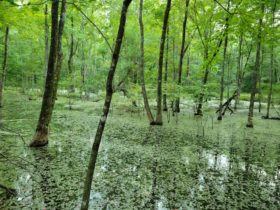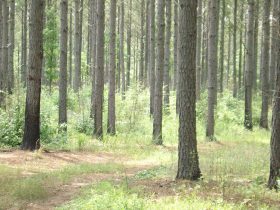

Investing In Timber – The Art & Science Of Thinning Trees
Investors see planted pine as a safe alternative
With interest rate low and the economy shaky, many investors see timberland as a safe place to put money. In fact, over the last four years we have seen a significant shift in the motivations of people buying Alabama land for sale. Before 2008 and going back to the 1980’s, the most common reason we saw for buying land was finding a good place to hunt. Four years later there has been a large increase in people buying land for it’s financial attributes. And in Alabama, the best way to make money with land is to buy land planted in loblolly pines.
Making money: it’s about tree diameter
The investment life cycle of a loblolly pine forest is about 30 years. Two or three times along the way it’s important to control the spacing of the trees (the income is nice too). Knowing when to do this and which trees to take is why people go to forestry school. But, the reason is simple. Over the investment life cycle, pine trees pass through three distinct “price steps”. By “step”, we mean market value ($ / ton) of the wood. Each step is diameter dependent, and diameter growth is spacing dependent.
The value “steps”
In relative terms, there is the $5/ton step (small trees for pulpwood), the $15/ton step (middle-sized trees for small lumber) and the $25/ton step (large trees for large lumber). The faster your trees “march” through these steps, the more money you’ll make. Too many trees for too long, and they’ll linger in the $5 step or the $15 step, sometimes for 10 extra years. Properly thinned, each tree can maximize diameter growth and has the potential to reach the last step where they can be worth 5 times more (per ton) than the first “step” where they all start. The faster they get there, the greater your financial reward.

Featured Blog Posts

Conservation Easements – the good and the bad
Conservation easements are a tool landowners can use to raise…
Read More

How Not To Sell Timber
Decisions of how and when to sell timber are difficult…
Read More
- Archives
- October 2021
- July 2018
- December 2017
- June 2016
- January 2015
- December 2014
- September 2014
- May 2014
- January 2014
- November 2013
- October 2013
- August 2013
- July 2013
- June 2013
- May 2013
- March 2013
- December 2012
- October 2012
- September 2012
- August 2012
- July 2012
- June 2012
- May 2012
- April 2012
- October 2011
- September 2011
- Categories
- Featured
- News
- Opinions
- Real Estate
- Timber
- Trends
- Uncategorized